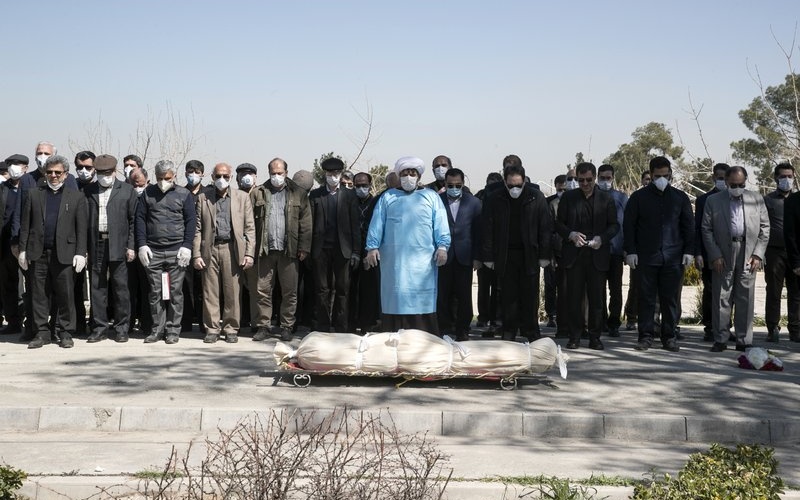Mourners at the funeral of Revolutionary Guards official Farzad Tazari at the Behesht-e-Zahra cemetery just outside Tehran, Iran, March 10, 2020 (Mahmood Hosseini/Tasnim)
UPDATE, AUGUST 3:
While denying the BBC report of an actual Coronavirus death toll of almost 42,000 as of July 20, the Health Ministry has warned Iranians of a fatality every 7 minutes.
State TV showed several people without masks or social distancing in a busy Tehran street.
The National Coronavirus Combat Taskforce was scheduled on Monday to consider the postponement of nationwide university entrance examinations for more than 1 million candidates.
But President Hassan Rouhani preferred dissemination of a message defying Iran’s economic crisis:
The economic realities of the country show that, by taking advantage of economic capabilities and capacities and coordination between all bodies of the country and cohesion in the management and implementation of coordinated programmes, we can get out of unprecedented bottlenecks due to maximum pressure from enemies in economic warfare.
ORIGINAL ENTRY, AUGUST 2: Medical records indicate that almost 42,000 people have died in Iran from Coronavirus.
The figure, for the period up to 20 July, is almost 150% higher than the Islamic Republic’s official death toll of 17,405 presented by the Health Ministry on Monday.
The higher total is in records and lists given to the BBC by an anonymous source. The documents record 451,024 cases, compared to the official tally of 312,035.
Medical staff listed the first Covid-19 death on January 22. By February 19, when Iranian authorities finally acknowledged a fatality, 52 patients had perished.
Fearful that the virus would depress turnout in Parliamentary elections on February 21, Iranian officials said little about the outbreak, which started in the religious city of Qom. The day after the election, the Supreme Leader claimed fear of the virus was a “Western plot” to deter participation, which was a historically-low 41%. President Hassan Rouhani said days later that news of the disease was an “enemy conspiracy“.
Authorities were also concerned that the outbreak could renew periodic mass protests about economic and social conditions. In November, there were marches across Iran when the Government suddenly increased petrol prices by 50% to 200%. Security forces killed at least 304 protesters, according to documentation by Amnesty International.
In January, more rallies were sparked by the Iranian military’s cover-up of its shootdown of an Ukrainian passenger jet, killing 176 passengers and crew including more than 100 Iranians.
Dr. Nouroldin Pirmoazzen, a former MP and Health Ministry, summarized that the regime was “anxious and fearful of the truth”: “[It] was afraid that the poor and the unemployed would take to the streets.”
In March, Iranian officials expelled a team from the international health organisation Médecins Sans Frontières, only hours after it arrived in Isfahan Province in central Iran to set up a mobile hospital and deliver medical assistance.
Discovering the Deaths
Officials, including the Supreme Leader, began acknowledging a serious situation at the start of March. However, medics, activists, and some Iranian officials said the toll of deaths and cases was far higher than the Health Ministry’s announcements. A Parliamentary report in April said cases were more than double the official total.
The records include details of daily admissions to hospitals across Iran, including names, age, gender, symptoms, date and length of periods spent in hospital, and patients’ underlying conditions. The data matches other information held by the BBC.
In Tehran, 8,120 people have died with Covid-19 or symptoms of the virus. Qom has had 1,419 deaths.
The 1,916 deaths among foreign nationals point to a high toll amongst migrants and refugees, most from neighboring Afghanistan.
The Government imposed restrictions in March, at the time of Iranian New Year, and cases sank to an official low on 803 on May 2. However, amid Iran’s economic crisis, the Government began reopening businesses and other public spaces from April 11, and cases roses by 200% to 300% from mid-May.
President Hassan Rouhani said last month, as he presented a Parliamentary report, that 25 million of Iran’s 84 million population are infected.

